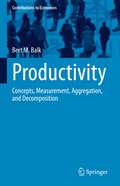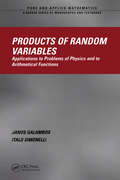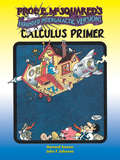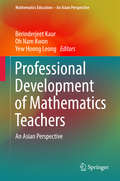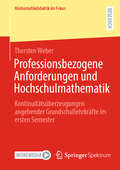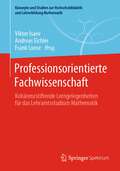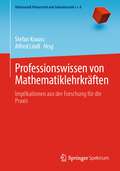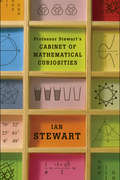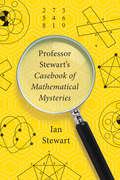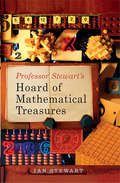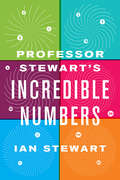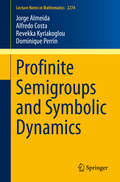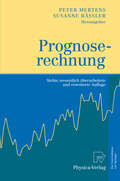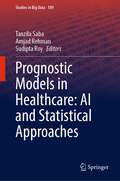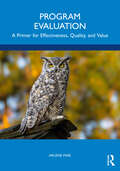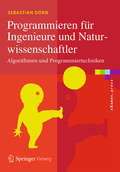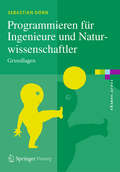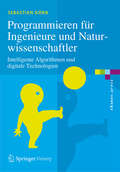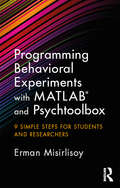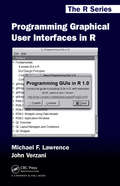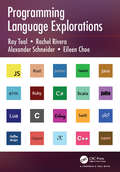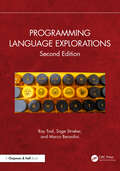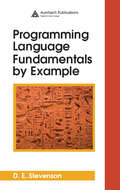- Table View
- List View
Productivity: Concepts, Measurement, Aggregation, and Decomposition (Contributions to Economics)
by Bert M. BalkThis book develops the theory of productivity measurement using the empirical index number approach. The theory uses multiplicative indices and additive indicators as measurement tools, instead of relying on the usual neo-classical assumptions, such as the existence of a production function characterized by constant returns to scale, optimizing behavior of the economic agents, and perfect foresight. The theory can be applied to all the common levels of aggregation (micro, meso, and macro), and half of the book is devoted to accounting for the links existing between the various levels. Basic insights from National Accounts are thereby used. The final chapter is devoted to the decomposition of productivity change into the contributions of efficiency change, technological change, scale effects, and input or output mix effects. Applications on real-life data demonstrate the empirical feasibility of the theory. The book is directed to a variety of overlapping audiences: statisticians involved in measuring productivity change; economists interested in growth accounting; researchers relating macro-economic productivity change to its industrial sources; enterprise micro-data researchers; and business analysts interested in performance measurement.
Products of Random Variables: Applications to Problems of Physics and to Arithmetical Functions (Chapman & Hall/CRC Pure and Applied Mathematics)
by Janos Galambos Italo SimonelliProducts of Random Variables explores the theory of products of random variables through from distributions and limit theorems, to characterizations, to applications in physics, order statistics, and number theory. It uses entirely probabilistic arguments in actualizing the potential of the asymptotic theory of products of independent random variab
Prof. E. McSquared's Calculus Primer: Expanded Intergalactic Version!
by Howard Swann John Johnson"Highly recommended." — The Times (London) Educational Supplement"It will delight both young and old." — The American Mathematical Monthly"A truly lively and unusual, not to mention precise, textbook." — New York Public Library"The calculus book looks great. There has never been anything like it." — Martin Gardner, longtime author of the "Mathematical Games" column for Scientific AmericanFilled with humorous illustrations as well as lively and absorbing mathematical learning, this calculus comic book requires only a familiarity with high school algebra and a sense of humor. Prof. E. McSquared introduces each concept in differential calculus in the form of a memorable character and helps readers develop their intuitive powers. A lifesaver for struggling students and a treat for the mathematically minded, the book includes helpful exercises and complete solutions.
Professional Development of Mathematics Teachers
by Berinderjeet Kaur Oh Nam Kwon Yew Hoong LeongThis book offers a counterpart to the extensive corpus of literature available on the same topic from a Western perspective. It showcases innovative approaches to professional development of mathematics teachers in Asian countries, and reports on both empirical and expository studies of teachers' professional development in these counties. It provides scholars from non-English-speaking and under-represented Asian countries the opportunity to engage in discourse with other scholars in the field, and is the first book to present substantial contributions from scholars in Asia on the professional development of mathematics teachers in their respective countries. It includes perspectives that shed valuable light on how the approaches pursued in Asian countries resemble or differ from those in the West.
Professionsbezogene Anforderungen und Hochschulmathematik: Kontinuitätsüberzeugungen angehender Grundschullehrkräfte im ersten Semester (Mathematikdidaktik im Fokus)
by Thorsten WeberIm Fokus der Arbeit steht der Übergang von der Schule zur Hochschule, explizit die Überzeugungen der Studierenden zum Zusammenhang zwischen Schulmathematik und Hochschulmathematik sowie die Überzeugungen der Studierenden zur Relevanz der Hochschulmathematik für die zukünftige Lehrtätigkeit. Neben einer theoretisch fundierten Begriffsbildung rund um die Problematik der doppelten Diskontinuität basieren die Erkenntnisse der Studie auf quantitativen Daten, die mittels Fragebogen zu Beginn des Studiums und zum Ende des ersten Semesters an drei deutschen Universitäten erhoben wurden. Übergeordnetes Ziel ist es herauszuarbeiten, mit welchen Kontinuitätsüberzeugungen Grundschullehramtsstudierende ins Studium starten und welchen Einfluss das erste Semester auf diese Überzeugungen hat. Die Daten zeigen, dass die Problematik der doppelten Diskontinuität im Grundschullehramtsstudium aktuell ist und auch schon zu Studienbeginn von der Universität abhängen könnte, an der studiert wird. Zudem zeigt die Studie vielfältige Ergebnisse zu bestimmten Überzeugungen, zu denen auch Wechselwirkungen zwischen Überzeugungen und Studium analysiert werden.
Professionsorientierte Fachwissenschaft: Kohärenzstiftende Lerngelegenheiten für das Lehramtsstudium Mathematik (Konzepte und Studien zur Hochschuldidaktik und Lehrerbildung Mathematik)
by Andreas Eichler Frank Loose Viktor IsaevSubstantielles fachliches Wissen ist eine notwendige Grundlage dafür, dass Lehrerinnen und Lehrer einen attraktiven und erfolgreichen Mathematikunterricht gestalten können. Wie aber muss dieses fachliche Wissen genau aussehen? Auf welche Weise wird es bei der Planung und Durchführung von Unterricht genutzt? Wie kann man es im Studium auf eine Weise erwerben, die es für didaktisches Handeln anschlussfähig macht? Der vorliegende Band gibt Antworten auf diese Fragen. Er diskutiert kohärenzstiftende Lerngelegenheiten in der Lehramtsausbildung, die in regulären Veranstaltungen an Hochschulen systematisch evaluiert wurden.Im ersten Teil des Bandes steht die Professionsorientierung in Vorlesungen zum Lehramtsstudium im Fokus. Dabei wird der Frage nachgegangen, wie das mathematische Fachwissen einer Lehrkraft beschaffen sein muss, um unterrichtlich wirksam zu werden. Auf der Basis verschiedener theoretischer Modelle werden dazu mathematische Grundveranstaltungen im Lehramtsstudium analysiert. Im zweiten Teil des Bandes stehen Übungsveranstaltungen mit einem Schwerpunkt auf der Gestaltung von Aufgaben im Mittelpunkt. Neben einer Klassifikation von Aufgaben werden Konzepte vorgestellt, wie durch spezifische Übungen der Zusammenhang zwischen Hochschulmathematik und der professionellen Tätigkeit von Lehrkräften deutlich gemacht werden kann. Im dritten Teil des Bandes werden schließlich Seminare als weitere Form der professionsorientierten Ausbildung von Lehrkräften betrachtet. Hierbei geht es um spezifische Aspekte der Professionsorientierung wie etwa die Kompetenz zur Nutzung digitaler Werkzeuge oder vertiefende mathematische Themen wie die Differentialgeometrie. Die Evaluationen in den drei Veranstaltungsformen zielen auf die Bewertung von Materialien, die kognitive Entwicklung und schließlich die Veränderung von affektiven Variablen der Lehramtsstudierenden.
Professionswissen von Mathematiklehrkräften: Implikationen aus der Forschung für die Praxis (Mathematik Primarstufe und Sekundarstufe I + II)
by Stefan Krauss Alfred LindlDer vorliegende Band vereinigt erstmals die vielfältigen und einflussreichsten empirischen Untersuchungsansätze zum professionellen Wissen von Mathematiklehrkräften der beiden letzten Jahrzehnte. Er ermöglicht allen Leserinnen und Lesern unabhängig von ihren Vorkenntnissen einen raschen Einstieg in dieses zentrale Thema fachdidaktischer Forschung und gewährt einen informationsreichen Überblick über aktuelle Entwicklungen in diesem Bereich der Bildungsforschung. Die wesentlichen Ergebnisse zum pädagogischen Wissen, zum fachdidaktischen Wissen und zum Fachwissen, den Kernkategorien des Professionswissens von Mathematiklehrkräften, werden in neun Kapiteln systematisch und prägnant aufbereitet, immer illustriert anhand konkreter Testinhalte und -aufgaben für Lehrkräfte. Hierbei liegt ein besonderes Augenmerk darauf, die empirischen Erkenntnisse allgemein verständlich und anhand zahlreicher praktischer Beispiele für alle Interessentengruppen handlungsnah zu veranschaulichen, ihren unmittelbaren Praxisbezug zu verdeutlichen und so für die eigene Unterrichtstätigkeit wie auch die Aus-, Fort- und Weiterbildung von Mathematiklehrkräften fruchtbar zu machen. Dieser übersichtliche, gut lesbare Sammelband eignet sich somit einerseits für angehende Mathematiklehrkräfte wie auch Mathematiklehrkräfte im Beruf zum Selbststudium. Andererseits bietet er insbesondere allen, die an den verschiedenen Qualifizierungsphasen der Lehrkräftebildung beteiligt sind, einen reichhaltigen, unentbehrlichen Fundus an detailliert beschriebenen Unterrichtssituationen, empirisch abgesicherten fachdidaktischen Empfehlungen sowie konkreten Handlungsoptionen. Er vermittelt wertvolle Anregungen zur Gestaltung von qualitätsvollem Mathematikunterricht, zu dessen innovativer Weiterentwicklung und Optimierung und zur Förderung der mathematischen Kompetenzen von Schülerinnen und Schülern als dessen Zielkriterium.
Professor Stewart's Cabinet of Mathematical Curiosities
by Ian StewartFrom one of the worldOCOs most beloved popular writers on mathematics, a fun and challenging collection of games, puzzles, stories, and more"
Professor Stewart's Casebook of Mathematical Mysteries
by Ian StewartIn Professor Stewart’s Casebook of Mathematical Mysteries, acclaimed mathematician Ian Stewart presents an enticing collection of mathematical curios and conundrums. With a new puzzle on each page, this compendium of brainteasers will both teach and delight. Guided by stalwart detective Hemlock Soames and his sidekick, Dr. John Watsup, readers will delve into almost two hundred mathematical problems, puzzles, and facts. Tackling subjects from mathematical dates (such as Pi Day), what we don’t know about primes, and why the Earth is round, this clever, mind-expanding book demonstrates the power and fun inherent in mathematics.
Professor Stewart's Hoard of Mathematical Treasures
by Ian StewartOpening another drawer in his Cabinet of Curiosities, renowned mathematics professor Ian Stewart presents a new medley of games, paradoxes, and riddles in Professor Stewart’s Hoard of Mathematical Treasures. With wit and aplomb, Stewart mingles casual puzzles with grander forays into ancient and modern mathematical thought. Amongst a host of arcane and astonishing facts about every kind of number from irrational and imaginary to complex and cuneiform, we learn: - How to organize chaos - How matter balances anti-matter - How to turn a sphere inside out (without creasing it) - How to calculate pi by observing the stars - . . . and why you can’t comb a hairy ball. Along the way Stewart offers the reader tantalizing glimpses of the mathematics underlying life and the universe. Mind-stretching, enlightening, and endlessly amusing, Professor Stewart’s Hoard of Mathematical Treasures will stimulate, delight, and enthrall.
Professor Stewart's Incredible Numbers
by Ian StewartAt its heart, mathematics is about numbers, our fundamental tools for understanding the world. In Professor Stewart’s Incredible Numbers, Ian Stewart offers a delightful introduction to the numbers that surround us, from the common (Pi and 2) to the uncommon but no less consequential (1. 059463 and 43,252,003,274,489,856,000). Along the way, Stewart takes us through prime numbers, cubic equations, the concept of zero, the possible positions on the Rubik’s Cube, the role of numbers in human history, and beyond! An unfailingly genial guide, Stewart brings his characteristic wit and erudition to bear on these incredible numbers, offering an engaging primer on the principles and power of math.
Profinite Semigroups and Symbolic Dynamics (Lecture Notes in Mathematics #2274)
by Dominique Perrin Jorge Almeida Alfredo Costa Revekka KyriakoglouThis book describes the relation between profinite semigroups and symbolic dynamics. Profinite semigroups are topological semigroups which are compact and residually finite. In particular, free profinite semigroups can be seen as the completion of free semigroups with respect to the profinite metric. In this metric, two words are close if one needs a morphism on a large finite monoid to distinguish them. The main focus is on a natural correspondence between minimal shift spaces (closed shift-invariant sets of two-sided infinite words) and maximal J-classes (certain subsets of free profinite semigroups). This correspondence sheds light on many aspects of both profinite semigroups and symbolic dynamics. For example, the return words to a given word in a shift space can be related to the generators of the group of the corresponding J-class. The book is aimed at researchers and graduate students in mathematics or theoretical computer science.
Prognoserechnung
by Peter Mertens Susanne RässlerMit diesem Buch liegen kompakte Beschreibungen von Prognoseverfahren vor, die vor allem in Systemen der betrieblichen Informationsverarbeitung eingesetzt werden. Praktiker mit langjähriger Prognoseerfahrung zeigen außerdem, wie die einzelnen Methoden in der Unternehmung Verwendung finden und wo die Probleme beim Einsatz liegen. Das Buch wendet sich gleichermaßen an Wissenschaft und Praxis. Das Spektrum reicht von einfachen Verfahren der Vorhersage über neuere Ansätze der künstlichen Intelligenz und Zeitreihenanalyse bis hin zur Prognose von Softwarezuverlässigkeit und zur kooperativen Vorhersage in Liefernetzen. In der siebenten, wesentlich überarbeiteten und erweiterten Auflage werden neue Vergleiche von Prognosemethoden, GARCH-Modelle zur Finanzmarktprognose, "Predictive Analytics" als Variante der "Business Intelligence" und die Kombination von Vorhersagen mit Elementen der Chaostheorie berücksichtigt.
Prognostic Models in Healthcare: AI and Statistical Approaches (Studies in Big Data #109)
by Sudipta Roy Tanzila Saba Amjad RehmanThis book focuses on contemporary technologies and research in computational intelligence that has reached the practical level and is now accessible in preclinical and clinical settings. This book's principal objective is to thoroughly understand significant technological breakthroughs and research results in predictive modeling in healthcare imaging and data analysis. Machine learning and deep learning could be used to fully automate the diagnosis and prognosis of patients in medical fields. The healthcare industry's emphasis has evolved from a clinical-centric to a patient-centric model. However, it is still facing several technical, computational, and ethical challenges. Big data analytics in health care is becoming a revolution in technical as well as societal well-being viewpoints. Moreover, in this age of big data, there is increased access to massive amounts of regularly gathered data from the healthcare industry that has necessitated the development of predictive models and automated solutions for the early identification of critical and chronic illnesses. The book contains high-quality, original work that will assist readers in realizing novel applications and contexts for deep learning architectures and algorithms, making it an indispensable reference guide for academic researchers, professionals, industrial software engineers, and innovative model developers in healthcare industry.
Program Evaluation: A Primer for Effectiveness, Quality, and Value
by Arlene FinkThis timely, unique, and insightful book provides students and practitioners with the tools and skills needed to evaluate social and policy programs across a range of disciplines—from public health to social work to education—enabling the allocation of scarce human and financial resources to advance the health and well-being of individuals and populations. The chapters are organized according to the main tasks involved in conducting an evaluation to produce unbiased evidence of program effectiveness, quality, and value. The chapters include methods for selecting and justifying evaluation questions or hypotheses, designing evaluations, sampling participants, selecting information sources, and ensuring reliable and valid measurement. The final section of the book is focused around managing and analyzing data and transparently reporting the results in written and oral form. The book features international case studies throughout, covers quantitative, qualitative, and mixed-method approaches, and is also informed by new online methods developed during the COVID-19 pandemic. Among the book’s unique features is a focus on international standards for conducting ethical evaluations and avoiding research misconduct. Also featuring checklists, example forms, and summaries of the key ideas and topics, this very practical book is essential reading for students in the social, behavioral, and health sciences, and will be a key resource for professionals in the field.
Programa de matemáticas [Grade 1], Libro del alumno: Libro del alumno (Grade 1) (ORIGO Stepping Stones)
by James Burnett Calvin Irons Peter StowasserNIMAC-sourced textbook
Programa de matemáticas: Libro de práctica (Grade 1) (ORIGO Stepping Stones)
by James Burnett Calvin Irons Peter StowasserNIMAC-sourced textbook
Programmieren für Ingenieure und Naturwissenschaftler
by Sebastian DörnZiel des Buches ist es, Studierenden der Ingenieur- oder Naturwissenschaften die Programmierung als Schlüsselqualifikation mit zahlreichen Anwendungsmöglichkeiten vorzustellen. Großer Wert wird auf eine praxisorientierte und verständliche Darstellung gelegt. Der Autor behandelt die Anwendungsbereiche des Operations Research, der Medizinischen Informatik und der Automatisierungstechnik. Neben der Darstellung objektorientierter Entwurfsmuster werden zentrale Programmierkonzepte und fortgeschrittene Datenstrukturen vorgestellt. Suchalgorithmen, Graphen, Automaten und reguläre Sprachen werden dem Leser praxisnah vermittelt. Die Grundlagen zur Bildverarbeitung im Bereich der Bildfilterung, Registrierung und Segmentierung runden das Buch ab.
Programmieren für Ingenieure und Naturwissenschaftler: Grundlagen (eXamen.press)
by Sebastian DörnZiel des Buches ist es, Studierenden der Ingenieur- oder Naturwissenschaften die Programmierung als Schlüsselqualifikation mit zahlreichen Anwendungsmöglichkeiten vorzustellen. Die Umsetzung von Programmierkonzepten und algorithmischen Verfahren erfolgt in diesem Buch in Java. Im ersten Teil gibt der Autor eine Einführung in die Grundkonzepte von Java, im zweiten Teil werden algorithmische Verfahren aus dem Bereich der Numerik, sowie allgemeine Methoden zum Entwurf von Algorithmen vorgestellt. Im dritten Teil werden Grundlagen der objektorientierten Programmierung dargestellt sowie ein Überblick über die Erstellung von graphischen Benutzeroberflächen gegeben. Ein Kapitel zu diversen Anwendungen aus dem Bereich der Ingenieur- und Naturwissenschaften sowie Aufgaben und Lösungen in jedem Kapitel runden das Buch ab.
Programmieren für Ingenieure und Naturwissenschaftler: Intelligente Algorithmen und digitale Technologien (eXamen.press)
by Sebastian DörnZiel des Buches ist es, Ingenieuren oder Naturwissenschaftlern die Programmierung als Schlüsselqualifikation mit zahlreichen Anwendungsmöglichkeiten vorzustellen. Der Autor erläutert algorithmische Methoden, die heute hinter digitalen Produkten und Dienstleistungen stehen. Zentrale Anwendungen sind die Künstliche Intelligenz, das Data Mining, die Predictive Analytics, die Industrie 4.0 oder das Internet der Dinge. Die digitale Datenanalyse mit den zugehörigen Algorithmen ist die zentrale Grundlage vieler neuer IT-Technologien. Hierzu werden große Datenmengen verschiedenster Anwendungsfelder verarbeitet und auf gewisse Muster analysiert, um die relevanten Informationen zu extrahieren. Diese sogenannten intelligenten Verfahren sind die Basis für nahezu alle Innovationen in unserer digitalisierten Welt. Mit Hilfe dieser Art der Informationsverarbeitung werden durch die Kombination von mathematischen Modellen und algorithmischen Verfahren neue digitale Geschäftsmodelle erschaffen.
Programming Behavioral Experiments with MATLAB and Psychtoolbox: 9 Simple Steps for Students and Researchers
by Erman MisirlisoyHuman behavior is fascinating so it’s no surprise that psychologists and neuroscientists spend their lives designing rigorous experiments to understand it. MATLAB is one of the most widely used pieces of software for designing and running behavioral experiments, and it opens up a world of quick and flexible experiment programming. This book offers a step-by-step guide to using MATLAB with Psychtoolbox to create customisable experiments. Its pocket size and simple language allow you to get straight to the point and help you to learn fast in order to complete your work in great time. In nine simple steps, it guides you all the way from setting parameters for your experiment to analysing the output. Gone are the daunting days of working through hundreds of irrelevant and complicated documents, as in this handy book, Erman Misirlisoy coaxes you in the right direction with his friendly and encouraging tricks and tips. If you want to learn how to develop your own experiments to collect and analyse behavioral data, then this book is a must-read. Whether you are a student in experimental psychology, a researcher in cognitive neuroscience, or simply someone who wants to run behavioral tasks on your friends for fun, this book will offer you the skills to succeed.
Programming Graphical User Interfaces in R (Chapman & Hall/CRC The R Series #5)
by Michael Lawrence John VerzaniProgramming Graphical User Interfaces with R introduces each of the major R packages for GUI programming: RGtk2, qtbase, Tcl/Tk, and gWidgets. With examples woven through the text as well as stand-alone demonstrations of simple yet reasonably complete applications, the book features topics especially relevant to statisticians who aim to provide a practical interface to functionality implemented in R. The book offers: A how-to guide for developing GUIs within R The fundamentals for users with limited knowledge of programming within R and other languages GUI design for specific functions or as learning tools The accompanying package, ProgGUIinR, includes the complete code for all examples as well as functions for browsing the examples from the respective chapters. Accessible to seasoned, novice, and occasional R users, this book shows that for many purposes, adding a graphical interface to one’s work is not terribly sophisticated or time consuming.
Programming Language Explorations
by Ray Toal Rachel Rivera Alexander Schneider Eileen Choe<P><P><i>Advisory: Bookshare has learned that this book offers only partial accessibility. We have kept it in the collection because it is useful for some of our members. Benetech is actively working on projects to improve accessibility issues such as these.</i> <P><P> Programming Language Explorations is a tour of several modern programming languages in use today. The book teaches fundamental language concepts using a language-by-language approach. As each language is presented, the authors introduce new concepts as they appear, and revisit familiar ones, comparing their implementation with those from languages seen in prior chapters. The goal is to present and explain common theoretical concepts of language design and usage, illustrated in the context of practical language overviews. <P><P>Twelve languages have been carefully chosen to illustrate a wide range of programming styles and paradigms. The book introduces each language with a common trio of example programs, and continues with a brief tour of its basic elements, type system, functional forms, scoping rules, concurrency patterns, and sometimes, metaprogramming facilities. <P><P>Each language chapter ends with a summary, pointers to open source projects, references to materials for further study, and a collection of exercises, designed as further explorations. Following the twelve featured language chapters, the authors provide a brief tour of over two dozen additional languages, and a summary chapter bringing together many of the questions explored throughout the text. <P><P>Targeted to both professionals and advanced college undergraduates looking to expand the range of languages and programming patterns they can apply in their work and studies, the book pays attention to modern programming practice, covers cutting-edge languages and patterns, and provides many runnable examples, all of which can be found in an online GitHub repository. The exploration style places this book between a tutorial and a reference, with a focus on the concepts and practices underlying programming language design and usage. Instructors looking for material to supplement a programming languages or software engineering course may find the approach unconventional, but hopefully, a lot more fun.
Programming Language Explorations
by Ray Toal Sage Strieker Marco BerardiniProgramming Language Explorations helps its readers gain proficiency in programming language practice and theory by presenting both example-focused, chapter-length explorations of fourteen important programming languages and detailed discussions of the major concepts transcending multiple languages. A language-by-language approach is sandwiched between an introductory chapter that motivates and lays out the major concepts of the field and a final chapter that brings together all that was learned in the middle chapters into a coherent and organized view of the field.Each of the featured languages in the middle chapters is introduced with a common trio of example programs and followed by a tour of its basic language features and coverage of interesting aspects from its type system, functional forms, scoping rules, concurrency patterns, and metaprogramming facilities. These chapters are followed by a brief tour of over 40 additional languages designed to enhance the reader’s appreciation of the breadth of the programming language landscape and to motivate further study.Targeted to both professionals and advanced college undergraduates looking to expand the range of languages and programming patterns they can apply in their work and studies, the book pays attention to modern programming practices, keeps a focus on cutting-edge programming patterns, and provides many runnable examples, all of which are available in the book’s companion GitHub repository. The combination of conceptual overviews with exploratory example-focused coverage of individual programming languages provides its readers with the foundation for more effectively authoring programs, prompting AI programming assistants, and, perhaps most importantly, learning—and creating—new languages.
Programming Language Fundamentals by Example
by D.E. StevensonSurveying the major programming languages that have hallmarked the evolution of computing, Programming Language Fundamentals by Example provides an understanding of the many languages and notations used in computer science, the formal models used to design phases, and the foundations of languages including linguistics. This textbook guides students through the process of implementing a simple interpreter with case-based exercises, questions, and a semester-long project that encompasses all of the concepts and theories presented in the book into one concrete example. It covers also such topics as formal grammars, automata, denotational and axiomatic semantics, and rule-based presentation.
